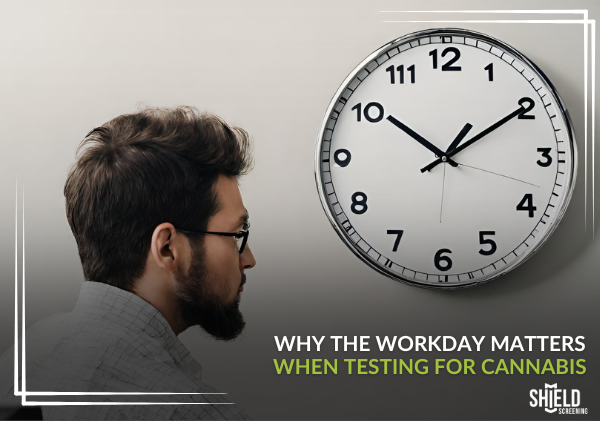
“We have a lot of good folks that maybe partake on the weekend, but Monday through Friday at work they don’t.” Motor Vehicle Manufacturer
The problem is conventional cannabis tests cannot distinguish between use that occurred five minutes ago from use that occurred five days or even five weeks ago. Traditional testing methods like oral fluid (saliva), urine, and hair are not capable of specifically isolating recent cannabis use and offer little information about whether an employee’s use has the potential to impact job performance on the day they use cannabis.
And that means the employees mentioned above would be in danger of failing a conventional cannabis test – even if they didn’t consume cannabis immediately before or during the workday.
Does that seem fair?
Simply put, these tests aren’t relevant to an employee’s workday because their detection windows extend beyond the workday.
WHAT IS A DETECTION WINDOW?
In cannabis testing, a window of detection indicates how long a test will detect THC (the principal psychoactive compound found in cannabis) in a biological sample, such as oral fluid (saliva), urine, hair, or breath. The detection window for THC varies depending on the sample type being used.
A precise window of detection helps employers enforce policies that prohibit use immediately before or while at work but do not penalize cannabis use outside of work.
A test with the narrowest window of detection would help the motor vehicle manufacturer mentioned above in deterring employees from using cannabis during the workday, a problem they are currently experiencing.
“There’s a growing concern. We’ll have people come to an orientation and they smell like marijuana.” – Motor Vehicle Manufacturer
That’s why the workday matters when we talk about cannabis testing.
WHAT IS THE BEST CANNABIS TESTING METHOD?
Different drug testing methods may suit certain situations depending on budget, testing environment, and the goal of the employer administering the test. If the goal is to determine recent use and whether an employee is a safety risk, then a breath test could be the best option. A breath test has the shortest THC detection window and is the only cannabis testing technology in which a positive result correlates with recent use and workday relevance.
ORAL FLUIDS
THC is detectable in oral fluid (saliva) for as long as 24-36 hours. THC enters oral fluids primarily through deposits in the mouth during use. When someone smokes or consumes an edible containing cannabis (such as gummies or a brownie), THC is sequestered in the oral mucosa or tissue in the mouth during use and released into the saliva. Even though an oral fluid cannabis test has a shorter detection window than urine, it is still much longer than a breath test.
URINE
Urine is the most common cannabis testing sample, in part, because it’s been around the longest and is required by federal agencies and contractors. Urine tests can detect THC for up to 30 days. This timeframe is somewhat dependent on factors such as the donor’s frequency of use and testing cutoff levels.
The detection window for urine is even longer than for oral fluid because THC is metabolized into various inactive metabolites before being excreted in urine. Rather than THC itself, these metabolites are the target of urine testing. The primary metabolite detected in urine tests is THC-COOH, but it is just one of the more than 80 inactive metabolites the body produces.
HAIR
Hair tests generally have the longest detection window — around 90 days after cannabis use. Similar to urine tests, hair tests don’t test for THC but instead test for the non-psychoactive THC metabolite THC-COOH. Unlike other tests that may start to detect THC minutes or hours after ingestion, it typically takes several days for THC-COOH to be detectable from hair tests because metabolites must first pass from the bloodstream to the hair follicles and then grow into the strands of hair. Starting from the scalp, every centimeter of hair length equates to an approximate one-month detection window.
BREATH
Breath provides the shortest detection window – detecting cannabis for just a few hours after use, the amount of time THC remains measurable in the breath after entering the bloodstream. As a result, breath is the most relevant test to isolate recent cannabis use that may impact an employee’s workday performance. A cannabis breath test can detect THC whether it is consumed through inhalation or ingestion. Additionally, the metabolite THC-COOH isn’t detected in a cannabis breath test, only the actual THC molecule.
When cannabis is consumed, THC is transferred into exhaled breath where it is detectable for only a few hours after use. The latest breath testing studies confirm THC is detectable in breath for approximately two to three hours after smoking. Beyond three hours, THC levels drop to virtually undetectable levels.
WHAT IS YOUR WORKPLACE CANNABIS TESTING GOAL?
Workplace drug testing for cannabis continues to be essential in maintaining safety and productivity, deterring use before or during work hours, and mitigating risk – but it should and can be fair for all parties involved. A recent use cannabis breath test can help employers avoid eliminating otherwise qualified job applicants.
As for that motor vehicle manufacturer we referenced earlier, they continue to have to fire employees for past cannabis use while struggling to find new employees who can pass a conventional cannabis test. Using a cannabis test that can tell them when – not just if – an employee used cannabis will ultimately save employees’ jobs and help fill the hiring pipeline with qualified candidates.
The HOUND® CANNABIS BREATHALYZER gives employers a way to detect and deter use correlating to an employee’s workday.
NEXT STEPS
For more information on mitigating workplace risk with cannabis breath testing, check out this on-demand webinar or connect with the Shield Screening team.
This blog is reprinted with permission from Hound Labs Inc., developers of the HOUND® CANNABIS BREATHALYZER.


